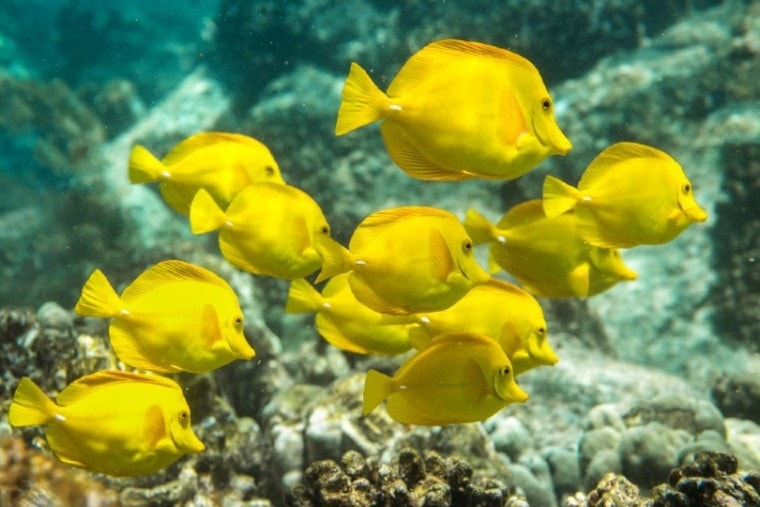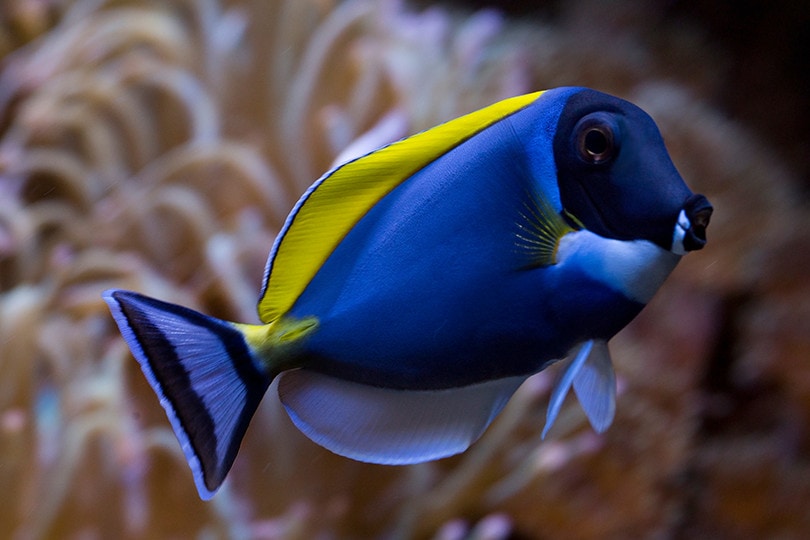10 Popular Types of Tangs & Surgeon Fish Species (with Pictures)

Tangs, commonly referred to as Surgeonfish are a species of marine fish. They prefer warmer water aquariums and feed on a diet primarily made up of vegetable matter. They come in a variety of vibrant colors that add an appeal to your aquarium. Although they are not very beginner-friendly, intermediates and those who have kept tropical tanks successfully should be able to care for them appropriately with few mistakes.
Tangs will generally form schools, with the exception of the blue powder tang who does show aggression to other surgeonfish. They require exceptionally large, heated tanks to thrive, a group of the smaller tang species can be kept in a 300 gallon or 1,136 liters, they should be added at the same time and relatively be the same size and from the same source.

General Overview of Tangs & Surgeon Fish

The 10 Popular Types of Tangs & Surgeon Fish
1. Powder Blue Tang

Powder blue tangs showcase a strikingly beautiful color, with a vibrant mix of blues and yellow colors. They are quite difficult to keep healthy and successfully, as they are sensitive to their environment and can be particularly aggressive to other tangs in the aquarium, and are quite territorial. Powder blue tangs body are made to fit into small spaces and consume algae on surfaces (they display a very slim body structure), which is a common favorite. They have the potential to grow to 9 inches in length and a lifespan of 30 to 45 years.
2. Yellow Tang

Yellow tangs have a beautiful and vibrant coloration. They are one of the smaller and hardier tangs available in the aquarium hobby. The male yellow tangs grow larger than females, generally reaching to 8 inches in length. They live up to about 30 years old. One benefit of this type of tang is that they can be kept in groups when bought together from the same store or if they are shipped from an online supplier together. They display an oval-shaped body with long and rounded top and bottom fins. During the night, the vibrant yellow color does fade a bit, but as soon as they are in light their vibrant yellow color will re-emerge.
3. Clown Tang
Clown tangs have a unique pattern on their bodies. This type of tang can reach over a foot in length and are quite active in their tanks, unfortunately, they do display aggressiveness to other fish species and even other tangs in the aquarium. They grow to about 12-14 inches in length. Their typical lifespan is between 25 to 30 years old. Their tail is exceptionally striking, the top part of its body has beautiful and intricate orange and blue patterns, with the head having a pattern of orange and white.
4. Yellow Eye Kole Tang
Kole tangs are known to be great algae grazers and display a beautiful coloration of dark blue and dark pink that fades into each other like an ombre effect. They have faint white dots covering their bodies. They are one of the least aggressive types of tangs and are at risk of being bullied by other tank mates. They roughly grow around 7 inches in length and live to about 10 years of age.
5. Achilles Tang
Achilles tang typically grows to about 9 inches and displays a semi-aggressive temperament. Their coloration consists of a purple and black mix with luminous blue and orange patterns. The ends of the tail are tinged white and almost transparent. These are one of the more advanced and delicate types of tang fish available and are not ideal for beginners or even intermediates in the hobby, even experts struggle to please them. They have a lifespan between 30 to 45 years of age, so they are quite a long-term commitment.
6. Purple Tang Fish
Purple tangs live to about 12 years of age, and as the name suggests, they have a purplish-blue coloration on their bodies, their pectoral fins and tail display a luminous yellow coloring, making this fish stand out in an aquarium. They generally grow to about 9 inches in length and have a very territorial nature, especially as they mature so keeping them with other aggressive tankmates or other types of tangs is not recommended.
7. Blue Spine Unicorn Tang
Typically, one of the larger growing tangs who reach a whopping 40 inches in length. Although their coloration is not as diverse as other types of tang fish, their color is still quite appealing. Living up to their name, they have a blue line on the ends of their fins and display a brilliant white and grey full body coloration and have 2 faint blue dots by the base of their tail. They really do look like an aquarium unicorn and can live between 30 to 45 years.
8. Chevron Tang
Juvenile chevron tangs have a mix of bright orange on the middle of their bodies and fully covering their tail as well as having a faint pattern. As they mature, the orange fades to a darker brown color and becomes covered with intricate patterning. They grow up to about 11 inches in length and live between 30 to 40 years of age. They can develop an aggressive temperament.
9. Brown Tang
The brown tang displays a brown and green coloration across their body and when they are younger, they may have a more colorful and striking body, the colors seem to neatly fade into each other. Although they can be rather plain looking, they live for about 30 to 45 years and grow to a length of 8.5 inches. They prefer large and spacious aquariums to thrive and live to their full potential.
10. Naso Tang
Naso tangs have appealing orange fins and a tail with a dark band shown vertically, they also look like they are wearing lipstick with their dark orange mouth. The rest of the body is a blue hue with yellow outlines behind the eyes. They live between 30 to 45 years old, although more commonly 30 years in captivity and longer in the wild. They grow to about 18 inches in length so require a decently sized tank. Blonde Naso tangs seem to be aggressive with other tangs in the aquarium.
With so many beautiful types of Tang (also know as surgeonfish), you may have a hard choice deciding which ones right for you. It is best to make sure you have the right tank size, set up and diet to accommodate the tang you choose as well as acknowledging most can potentially be a 40-year commitment. Keeping tangs in good conditions will have your tang thriving and living a long life in your care.
Featured Image: RugliG, Shutterstock



Không có nhận xét nào